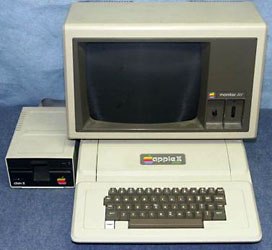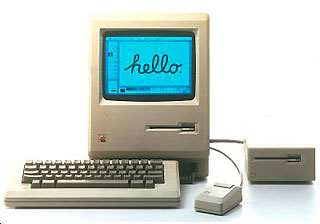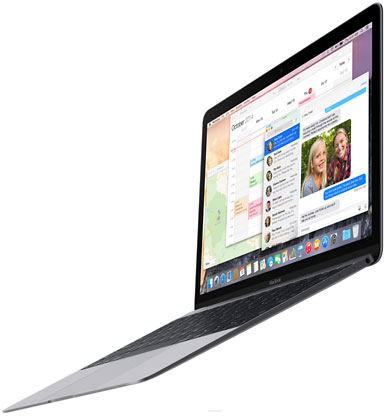One of the things that we computer nerds have always loved is tinkering with our machines. We have always enjoyed opening up our computers and expanding their capabilities. Unfortunately for us, the expandability of modern Macs ranges from limited to nonexistent.
 Back in 1976, when Woz was designing the Apple II, he insisted that it have 8 slots so that people could create new boards that would expand the capabilities of the unit. Steve Jobs, on the other hand, wanted the unit to only have 2 slots – one for a printer and one for a possible modem – because he wanted end-to-end control of the system. Fortunately Woz won the argument, and the Apple II retained the 8 slots that he designed it to have.
Back in 1976, when Woz was designing the Apple II, he insisted that it have 8 slots so that people could create new boards that would expand the capabilities of the unit. Steve Jobs, on the other hand, wanted the unit to only have 2 slots – one for a printer and one for a possible modem – because he wanted end-to-end control of the system. Fortunately Woz won the argument, and the Apple II retained the 8 slots that he designed it to have.
Fast forward several years to when the Macintosh was in development. Steve Jobs took over as the head of the Macintosh team and set to work on creating an easy to use “appliance” computer that anyone could learn to use with little effort.
 Steve Jobs insisted that the Macintosh be a “closed box”, unexpandable by users and even needed special tools just to open the unit. The finished product had just 128 KB of RAM (That is 1/8th of a MB for those of you who don’t know what KB stands for). While the Macintosh was a revolutionary machine, the limited memory severely limited the unit’s functionality and eliminated any possibility of multitasking.
Steve Jobs insisted that the Macintosh be a “closed box”, unexpandable by users and even needed special tools just to open the unit. The finished product had just 128 KB of RAM (That is 1/8th of a MB for those of you who don’t know what KB stands for). While the Macintosh was a revolutionary machine, the limited memory severely limited the unit’s functionality and eliminated any possibility of multitasking.
By the time that Steve Jobs left Apple in 1985, the Macintosh was looking outdated. Apple set out to create a new Macintosh that would be expandable. The result was the Macintosh Plus, which had expandable RAM via four 30-pin SIMM slots. It was also the first Mac to incorporate a SCSI connector (the Thunderbolt connector of its day) on the back for external devices. This machine was the first of a long line of expandable machines released by Apple, most of which also incorporated at least one expansion slot of some type to further increase the machine’s potential.
 When Steve Jobs came back in 1996, it was the beginning of the end for expandable Apple products. The iMac was the first new unit Apple released to not have some sort of expansion slot. It also was the first to drop all legacy support for accessories and peripherals made before its introduction.
When Steve Jobs came back in 1996, it was the beginning of the end for expandable Apple products. The iMac was the first new unit Apple released to not have some sort of expansion slot. It also was the first to drop all legacy support for accessories and peripherals made before its introduction.
Over the years, Apple has slowly eroded the expansion of the machines they produce. Here is a timeline that shows how Apple has progressively made their products more limited:
 2001: The iPod introduced the concept of non-replaceable battery in a portable electronic device.
2001: The iPod introduced the concept of non-replaceable battery in a portable electronic device.- 2003: The original Power Mac G5 was the first new professional Mac in over a decade not to have an upgradeable processor.
- 2008: The original MacBook Air was the first Mac laptop not to have expandable RAM, was also the first laptop not to have a user replaceable battery, and was the first Mac laptop in a decade not to have an internal optical drive as standard equipment or as an option.
- 2009: Apple drops support for all PowerPC-based Macs less than 3 years after the last PowerPC Mac was discontinued.
 2010: Apple introduces the first iPad, which I would argue was the first personal computer Apple built since the Mac 512K to have no expansion options whatsoever.
2010: Apple introduces the first iPad, which I would argue was the first personal computer Apple built since the Mac 512K to have no expansion options whatsoever.- 2011: The Mac mini drops its optical drive; all major refreshed Mac products did the same after this.
- 2012: The MacBook Pro with Retina Display models are introduced with no memory expansion whatsoever, due to the RAM being soldered on the logic board.
- 2012: The “slim” iMac body has removed the ability for users to easily upgrade memory because the display is held on by an adhesive (and removing this display is the only way to get to the internals).
 2013: The first new Mac Pro tower in several years is released with no expansion slots, no hard drive bays, and no way to upgrade the graphics processor or Video RAM.
2013: The first new Mac Pro tower in several years is released with no expansion slots, no hard drive bays, and no way to upgrade the graphics processor or Video RAM.- 2014: The new base model 1.4 GHz iMac arrives with soldered RAM, making RAM upgrades go from very difficult to impossible. This has shown to be the future for all subsequent 21.5″ iMacs.
- 2014: The Mac mini drops its Quad Core i7 processor option and also has soldered RAM on all models, making upgrades impossible.
 2015: The new MacBook eliminates the separate PCI-e based SSD in favor of soldered storage, making internal storage upgrades impossible. It also eliminated all I/O ports except for a single USB-C connector and a headphone jack. I wouldn’t be surprised if this was a trend that will find its way into more Macs such as the MacBook Pro and iMac.
2015: The new MacBook eliminates the separate PCI-e based SSD in favor of soldered storage, making internal storage upgrades impossible. It also eliminated all I/O ports except for a single USB-C connector and a headphone jack. I wouldn’t be surprised if this was a trend that will find its way into more Macs such as the MacBook Pro and iMac.
Now, I understand why Apple is doing this: Most consumers don’t ever actually upgrade their machines after they buy them. By removing expansion capabilities, Apple is able to make ever thinner, ever lighter, and ever sexier products.
It would appear that the days are numbered for those of us who enjoy tinkering with the insides of our machines if we intend on sticking with Apple products.
Maybe it wouldn’t be such a big deal if they weren’t so intent on selling the machines with such limited standard storage and memory. Yes, you can pay for additional memory and storage when you are buying a new machine, but always at a ridiculous markup. A Fusion Drive should not be optional equipment on a new desktop, and 8 GB of RAM might be enough now, but it won’t be in a few years time. It would be nice to see the following as the specs in base machines:
- Mac mini: 1.6 GHz Dual Core i5, 8 GB RAM, 1 TB Fusion Drive for $499
- iMac: 1.6 GHz Dual Core i5, 8 GB RAM, 1 TB Fusion Drive for $899
- iMac: 2.8 GHz Quad Core i5, 16 GB RAM, 1 TB Fusion Drive for $1099
- MacBook Air: 1.6 GHz Dual Core i5, 8 GB RAM, 256 GB SSD for $899
- 13″ MacBook Pro: 2.8 GHz Quad Core i5, 16 GB RAM, 256 GB SSD for $1299
I don’t think what I’ve listed here is asking too much. I realize that charging more makes for better profit margins, and it makes the shareholders happy, but the Mac is a very small part of Apple’s business these days, and I doubt that making these adjustments would but a very big dent in the overall profit margins.
At the end of the day, it would make for a much better user experience, and that is what Apple has always been about.
Keywords: #macexpansion #macupgrades
Short link:
searchword: unexpandable

